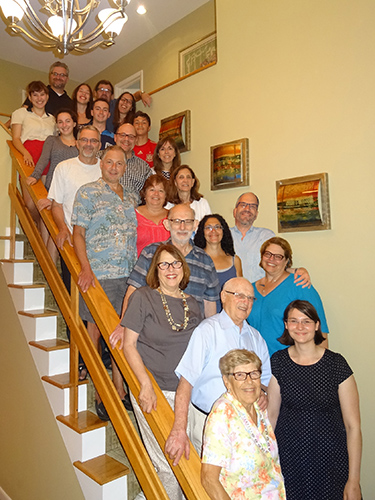Student From Freie Universität Berlin Meets Family She Researched in Visual History Archive

 Veronique, bottom right, with descendants of Leo Adler in New York
Veronique, bottom right, with descendants of Leo Adler in New YorkMickisch is a graduate student at Freie Universität Berlin, where, last year, she took a graduate seminar called “Expelled! Researching the Deportation of Polish Jews from Berlin in 1938,” taught by 2015 USC Shoah Foundation Teaching Fellows Alina Bothe and Gertrud Pickhan. The course uses the Visual History Archive to research the fates of specific families who were affected by the Berlin Polenaktion, Oct. 27-30, 1938. On these days, between 1,500 and 6,000 people of Polish descent were expelled from Berlin to Poland.
Mickisch researched the Adler family – mother Sabina and father Leo, and their children Norbert, Fedor and Rita. Using the Visual History Archive interviews of Norbert, Fedor and Rita, along with restitution files, the Federal Archive for the Victims of the Persecution of Jews and the USHMM Holocaust Survivors and Victims Database, Mickisch developed a full portrait of the family’s lives before, during and after the Holocaust.
Mickisch was able to get in touch with the family during the project and stayed in contact throughout the process. She conducted a phone interview with Rita and even sent some of the research to the family.
Last weekend, during a trip to New York, Mickisch had the opportunity to meet Rita Berger (neé Adler) and her extended family, including her husband Simon, children, grandchildren, nieces and nephews, at a barbecue at their home. Simon also gave testimony to USC Shoah Foundation; he is a survivor of the Lodz ghetto, Auschwitz and other labor camps.
Through her research, Mickisch constructed a detailed history of the Adler family. The family owned a fur shop in Berlin, and ran their business from their apartment after they were forced to give up the shop in 1935. In 1938, in the beginning of the Polenaktion, Leo and Norbert were deported from Berlin to Zbaszyn, Poland. In 1939, Sabina, Rita and Fedor were expelled from their apartment in Berlin and forced to leave Germany. They fled to Katowice, Poland. The family was later split between Warsaw and Dynów, Poland.
On September 16, 1939, Leo was murdered in the massacre of the male Jewish population of Dynów by the Einsatzgruppe Woyrsch. Like the other surviving Jews from the town, Rita and her brother Fedor were forced by the Germans to cross the river San for the Soviet-occupied zone of Poland. In Przemyśl, they reunited again with Sabina and Norbert. In spring 1940, all four were deported to Siberia for forced labor. Finally, on June 21, 1941, the USSR and the Polish government agreed to release Polish prisoners and deportees in the Soviet Union, and the Adler family moved to the city of Rubtsovsk, where they remained until the end of the war. They then went to Kulmbach, Germany.
The entire family immigrated to Israel in 1948. Norbert (after 25 years in Canada), Fedor and Rita each moved to the United States.
 Veronique, middle, with Rita and Simon Berger
Veronique, middle, with Rita and Simon BergerMickisch also got to see family photographs that she had not seen before, which were very moving. She and the family also discussed the lack of reparations for Holocaust victims from the German state in the post-war period, and they told her that the forms they had to fill out to try and get some reparations were humiliating. They also told Mickisch that people in Germany were not particularly interested in hearing or talking about the Holocaust in the decades after the war.
Mickisch said that from the beginning of her contact with Rita and her family, she was received very warmly and they were extremely eager to help her in her research. She was very moved by the opportunity to meet Rita and Simon in person, and was impressed by their warm, positive attitudes.
“Given the fates of their families and their own fate during the Holocaust, I was impressed by how lively and optimistic they are,” Mickisch said.
She felt extremely fortunate to have had access to three testimonies for her research of the Adler family because it allowed her to study just how devastating Nazi persecution was for real people. The testimonies also inspired her to continue researching more about this period and to examine the issues that affected the Adler family, which might otherwise go unnoticed.
“Apart from being emotionally more affected by such interviews, watching them and, in particular, meeting survivors such as Rita and Simon Berger in person imbues one with a greater sense of responsibility in one's historical research on this period and, frankly, one's participation and decision-making in society more generally,” she said.
Mickisch and the Bergers will reunite again in November, when a Stolpersteine memorial stone will be laid for Leo Adler in Berlin.